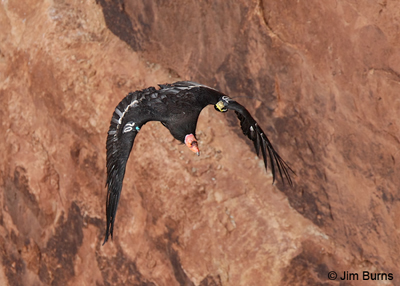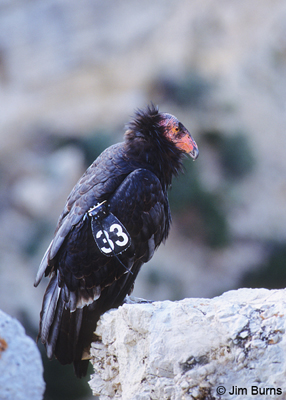
There’s been a lot of talk recently about the “wrong side of history” and the people and politicians in danger of being caught there. The catalysts for these discussions, of course, have been immigration policy and gender preference. Cultural change revolves around proponents reaching some nebulous “critical mass” whose size often depends upon the political power, wealth, and zeal of the opponents, and it got me to thinking about whether birds can be caught on the wrong side of history.
On Monday, January 27 of this year the Arizona Republic ran an article about the Grand Canyon’s California Condors and their continuing struggles with lead poisoning. In a column I wrote a little over five years ago (jimburnsphotos.com/pages/8-15-08.html) I concluded that I was optimistic about the slow changeover to copper bullets that seemed to be coming to Arizona’s hunting culture. The Republic’s January article tempered that optimism and reiterated the severity of the problem for our condors.
Most birders know the background numbers, only 22 condors left in the wild in 1980 when the decision was made to bring them all in for captive breeding. The Republic article fills in current figures, some of them shockingly sobering. Of the 210 condors now in the wild, 75 are currently in Arizona. Since the first Arizona releases at the Vermilion Cliffs 17 years ago, there have been 55 known Arizona condor deaths, 28 of them from lead poisoning. An additional 35 are missing and presumed dead.
It has become routine for most of Arizona’s condors to be recaptured annually to be tested for lead ingestion, and testing is done in the winter because observation of lethargic and starving condors follows the fall deer hunt like night follows day. Treatment involves twice a day injections of a chelating agent which binds the lead so the birds can excrete it. The known and expected life span of California Condors in the wild is 60 years, but no Arizona bird has made it past 16 due to the cumulative effect of the lead poisoning, this despite all the detox efforts. The female that made it to 16 was recaptured and treated every one of her 16 years before she finally succumbed.
California banned lead bullets in its condor areas in 2008, but Arizona has chosen instead to try a voluntary hunter program. Copper bullets cost more than lead, and Arizona spends $100,000 annually for hunters’ non-lead ammunition coupons and for educational materials asking hunters to take their gut piles to landfills. Voluntary compliance reached nearly 90% last fall on the Kaibab Plateau, but especially since condors are social feeders it takes only a few fragments of lead in a handful of gutpiles to endanger the entire condor recovery process, and now the birds are expanding their foraging range into southern Utah where a voluntary hunter program has only just begun.
Condor biologists are convinced the reintroduced condors have enough space and nature provided carrion to survive and thrive if copper replaces lead as the hunters’ preference. Of course state and national gun activists are lobbying against a California style ban and any arguments for copper bullets. Arizona Game and Fish has the numbers—of the 591 successful 2013 hunts, 69 hunters used lead and left offal in the field. Clearly, for the condor program survival, critical mass must be at or bumping 100%. If cultural change is coming to the North Kaibab, it is coming slowly. There is no need for deer hunting to be on the wrong side of history, but there is still the possibility that Arizona’s awesome Pleistocene relic will be. The jury called history is still out.
